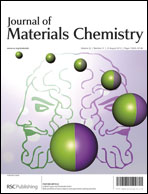Benzene tetracarboxylic acid doped polyaniline nanostructures: morphological, spectroscopic and electrical characterization†
Abstract
The in situ preparation of polyaniline nanotubes via assembly of an aromatic dopant acid is a challenging task at present in polymer chemistry. Here, we report the formation of PANI nanostructures doped with benzene 1,2,4,5-tetracarboxylic acid (BTCA), which simultaneously acts as a dopant acid as well as a structure-directing agent to produce high aspect ratio nanotubes having more or less uniform diameter. The diameter of the fibers is intricately tuned by changing the ratio of BTCA to aniline. The effect of dopant concentration in the polymer composites has been investigated with the help of 1H-NMR, UV-Vis and IR studies. It has also been demonstrated that the dopant acid plays an important role in the fiber formation, particularly in the nanotube formation. A comparative investigation with other tetracarboxylic acids has been made in the light of the variation of diameter. The outer diameter (OD) of PANI nanotubes depends on the size of the dopant tetracarboxylic acid under identical reaction conditions and it follows the order ODPTCA > ODNTCA > ODBTCA. Furthermore, it has been found that the conductivities of the BTCA–PANI nanotubes depend on the BTCA to aniline molar ratios, and the low temperature charge transports in these composites predominantly follow the three dimensional variable range hopping mechanism.


 Please wait while we load your content...
Please wait while we load your content...